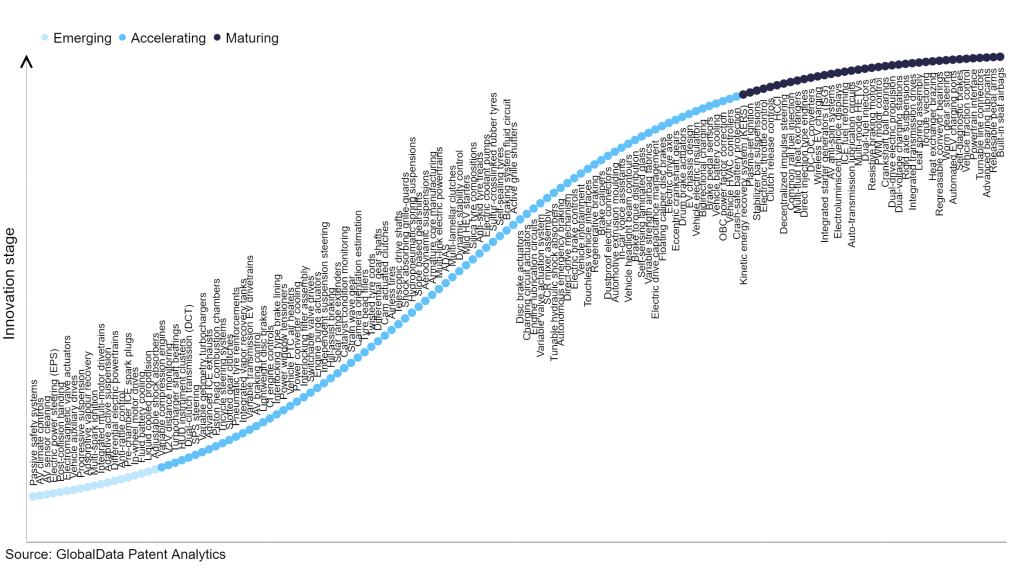The automotive industry continues to be a hotbed of patent innovation. Activity is driven by enhanced driving experience, range efficiency, and braking performance, and growing importance of technologies such as sensors, artificial intelligence, and machine learning. In the last three years alone, there have been over 1.7 million patents filed and granted in the automotive industry, according to GlobalData’s report on Innovation in automotive: brake pedal sensors. Buy the report here.
However, not all innovations are equal, and nor do they follow a constant upward trend. Instead, their evolution takes the form of an S-shaped curve that reflects their typical lifecycle from early emergence to accelerating adoption, before finally stabilizing and reaching maturity.
Identifying where a particular innovation is on this journey, especially those that are in the emerging and accelerating stages, is essential for understanding their current level of adoption and the likely future trajectory and impact they will have.
300+ innovations will shape the automotive industry
According to GlobalData’s Technology Foresight, which plots the S-curve for the automotive industry using innovation intensity models built on over one million patents, there are 300+ innovation areas that will shape the future of the industry.
Within the emerging innovation stage, integrated multi-motor drivetrains, electric power steering (EPS), and post-collision handing are useful technologies that are in the early stages of wider application and should be tracked closely. Variable compression engines, V2V distance monitoring, and turbocharger shaft bearings are some of the accelerating innovation areas, where adoption has been steadily increasing. Among maturing innovation areas are kinetic energy recovery system (KERS) and plasma-jet ignition, which are now well-established in the industry.
Innovation S-curve for the automotive industry

Brake pedal sensors is a key innovation area in automotive
For HEV, PHEV, and EV passenger cars, the brake pedal sensor is a significant factor in regenerative braking optimisation. The brake pedal stroke range, where the regeneration can be maximised, is precisely provided to the inverter.
GlobalData’s analysis also uncovers the companies at the forefront of each innovation area and assesses the potential reach and impact of their patenting activity across different applications and geographies. According to GlobalData, there are 30+ companies, spanning technology vendors, established automotive companies, and up-and-coming start-ups engaged in the development and application of brake pedal sensors.
Key players in brake pedal sensors – a disruptive innovation in the automotive industry
‘Application diversity’ measures the number of applications identified for each patent. It broadly splits companies into either ‘niche’ or ‘diversified’ innovators.
‘Geographic reach’ refers to the number of countries each patent is registered in. It reflects the breadth of geographic application intended, ranging from ‘global’ to ‘local’.
Patent volumes related to brake pedal sensors
Source: GlobalData Patent Analytics
Hyundai is one of the leading patent filers in brake pedal sensors. It develops and manufactures brake pedal sensors for electromechanical brake systems that improve braking response time by capturing driver intent, even before the brake pedal moves. Other prominent companies in the brake pedal sensors segment are HL Mando, Robert Bosch Stiftung, Kia, and Toyota Motor.
In terms of application diversity, Nissan Motor held the top position, while TDK and Kia stood in second and third positions, respectively. By means of geographic reach, LSP Innovative Automotive Systems leads the pack, followed by Nissan Motor and Boeing.
To further understand the key themes and technologies disrupting the automotive industry, access GlobalData’s latest thematic research report on Automotive.
Premium Insights
From

The gold standard of business intelligence.
Blending expert knowledge with cutting-edge technology, GlobalData’s unrivalled proprietary data will enable you to decode what’s happening in your market. You can make better informed decisions and gain a future-proof advantage over your competitors.






